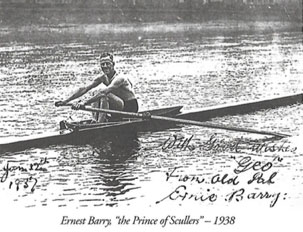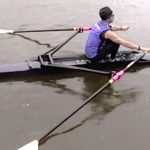The Sculling Stroke
For me it goes back to the “little black book” that Fitzpatrick compiled for me before I left for the USA 55 years ago. He went through the whole stroke cycle so it could be referred to as the Fitzpatrick/Joy stroke. The Waterman’s stroke is somewhat imprecise because they did not write about its specifics. Fitzpatrick/Joy contains elements of Orthodoxy, the trunk swing which is the keystone to the whole stroke, Fairbairn/Pearce, the drive and release, and Pearce/Fairbairn, the entry, and Orthodoxy again with the timing of the recovery, Pearce certainly emphasized the Bernoulli effect with his blades on the drive and the flat wrists/light hands at both ends of the slide; it was all fingers.
Where there is a direct link with the Watermen is through Hanlan. He was admired by the Orthodox people and by Fairbairn for his skills. So it was an electic stroke designed by Fitzpatrick from the three streams of his experience. The Pocock, Sculler’s entry in my terminology would come later when I moved to the states and I became aware of the importance of Pocock. These were really parallel streams of thought. This was truly brilliant on Fitz’s part bringing the key elements from the three techniques into a unified whole. However, my reference from actual experience is the Fitzpatrick stroke.It is close to the Pocock stroke on examination.

Here is a picture above of Ernie barry, a classic Thames Waterman in 1938.- great posture, straight athletic back, flat wrists, and over the keel.
Since Fitzpatrick additions have occurred periodically over the years. The trunk swing has evolved into a two part movement with the conscious swing followed by the glide forward. The motion of the shoulders are much more subtle and level during the drive. The “salt shaker’ action has been added to early part of the drive, again conscious to unconscious. The stroke rating has been elevated especially for the eights and the sculler’s entry makes this easier to achieve. The extensive use of slow motion sculling to improve the accuracy of the movements has been used. The emphasis on the integral stroke for the eights is a new approach. The flat wrists and finger action at each end of the slide is a great addition. The latest innovation is the emphasis on the small muscle action in an age where the large heavy muscle is usually employed. It is the recognition and promotion of athleticism that is employed in the coaching.
All through these years an important parallel development was occurring with the Pocock stroke from Seattle, Washington. George Pocock was truly a Thames Waterman who brought the stroke to America. It had far reaching impact on Coaching for close to 70 years in American college and club rowing. It is somewhat ironic now that the JoS and Pocock have joined forces to produce a West Coast Conference. As Stan Pocock once wrote, “his father would have approved of what we are doing at the JoS by offering an educational vehicle.”
With a little research I found that Pocock described the stroke as a one piece drive that parallels Fitzpatrick’s seamless pull with no fragmentation into legs, trunk, arms. Secondly, the “oarsman had to get a true feel of the boat. It literally has to become part of him.” This was true of Fitzpatrick as well. “Just as a skilled rider is said to become like part of his horse the skilled oarsman must become part of his boat.” Finally, the blades are kept close to the water on the recovery and missed water at the entry is reduced to a minimum. The blades simply skipped off the tops of waves. These are three ways in which the Pocock stroke and the Fitzpatrick stroke match.

















